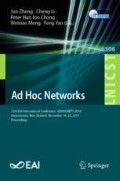Abstract
In response to the challenge of no difference coverage in seamless wide-area coverage scenarios, the 5G hyper-cellular network (HCN) is proposed to ensure user mobility and traffic continuity. In this network, Control Base Station (CBS) is responsible for control coverage, and the traffic base stations (TBSs) take care of high-speed data transmission. Firstly, this paper analyzes the spectral efficiency of different users by dividing the center region and edge region based on Poisson Voronoi Tessellation (PVT) model. For central users, a power control scheme is used to optimize the transmit power of TBSs. For edge users, a cooperative transmission technology and a power control scheme are employed to increase the spectral efficiency. In addition, the TBS sleeping strategy is used to further reduce inter-cell interference. Then, the analytical expressions of the spectral efficiency are derived by using random geometry. The simulation results illustrate that this scheme has a good effect on improving the spectral efficiency of the users with constant mobile velocity.
This work was supported by the National S&T Major Project (No. 2018ZX03001011).
Access this chapter
Tax calculation will be finalised at checkout
Purchases are for personal use only
References
Niu, Z., Gong, J., Zhou, S.: Research on hyper cellular mobile communication system based on energy efficiency and resource optimization. Telecommun. Sci. 30(12), 34–47 (2014)
Maxwell, C.: A Treatise on Electricity and Magnetism, 3rd edn. Clarendon, Oxford (1892)
Jacobs, S., Bean, P.: Fine particles, thin films and exchange anisotropy. Magnetism 3, 271–350 (1963)
Hoshino, K., Fujii, T.: Multi-cell coordinated power control with adjacent cell cooperative transmission considering actual environment. In: 2011 IEEE 73rd Vehicular Technology Conference (VTC Spring), pp. 1–5. Yokohama (2011)
Cui, Q., Song, H., Wang, H., Valkama, M., Dowhuszko, A.: Capacity analysis of joint transmission CoMP with adaptive modulation. IEEE Trans. Veh. Technol. 66(2), 1876–1881 (2016)
ElSawy, H., Hossain, E., Haenggi, M.: Stochastic geometry for modeling, analysis, and design of multi-tier and cognitive cellular wireless networks: a survey. IEEE Commun. Surv. Tutorials 15, 996–1019 (2013)
Lin, Y., Yu, W.: Downlink spectral efficiency of distributed antenna systems under a stochastic model. IEEE Trans. Wirel. Commun. 13(12), 6891–6902 (2014)
Cai, J.: Application of random geometry theory in cellular networks. Nanjing University of Posts and Telecommunications, Doctor (2016)
Yu, M., Kim, L.: Downlink capacity and base station density in cellular networks. In: 2013 11th International Symposium and Workshops on Modeling and Optimization in Mobile, Ad Hoc and Wireless Networks (WiOpt), Tsukuba Science City, pp. 119–124 (2013)
Mankar, D., Das, G., Pathak, S.: Load-aware performance analysis of cell center/edge users in random HetNets. IEEE Trans. Veh. Technol. 67(3), 119–124 (2018)
Park, J., Lee, N., Heath, W.: Cooperative base station coloring for pair-wise multi-cell coordination. IEEE Trans. Commun. 64(1), 402–415 (2016)
Moltchanov, D.: Distance distributions in random networks. Ad Hoc Netw. 10(6), 1146–1166 (2012)
Arshad, R., Elsawy, H., Sorour, S., et al.: Handover management in 5G and beyond: a topol-ogy aware skipping approach. IEEE Access 4, 9073–9081 (2016)
Author information
Authors and Affiliations
Corresponding author
Editor information
Editors and Affiliations
Rights and permissions
Copyright information
© 2019 ICST Institute for Computer Sciences, Social Informatics and Telecommunications Engineering
About this paper
Cite this paper
Zhang, D., Su, X., Cui, H., Liu, B., Ge, L., Zeng, J. (2019). Cooperative Transmission with Power Control in the Hyper-cellular Network. In: Zheng, J., Li, C., Chong, P., Meng, W., Yan, F. (eds) Ad Hoc Networks. ADHOCNETS 2019. Lecture Notes of the Institute for Computer Sciences, Social Informatics and Telecommunications Engineering, vol 306. Springer, Cham. https://doi.org/10.1007/978-3-030-37262-0_13
Download citation
DOI: https://doi.org/10.1007/978-3-030-37262-0_13
Published:
Publisher Name: Springer, Cham
Print ISBN: 978-3-030-37261-3
Online ISBN: 978-3-030-37262-0
eBook Packages: Computer ScienceComputer Science (R0)

